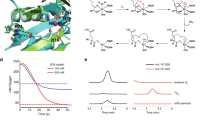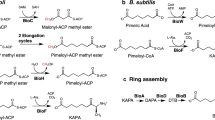Abstract
D-Ornithine has previously been suggested to enhance the expression of pyrrolysine-containing proteins. We unexpectedly discovered that uptake of D-ornithine results in the insertion of a new amino acid, pyrroline-carboxy-lysine (Pcl) instead of the anticipated pyrrolysine (Pyl). Our feeding and biochemical studies point to specific roles of the poorly understood Pyl biosynthetic enzymes PylC and PylD in converting L-lysine and D-ornithine to Pcl and confirm intermediates in the biosynthesis of Pyl.
This is a preview of subscription content, access via your institution
Access options
Subscribe to this journal
Receive 12 print issues and online access
$259.00 per year
only $21.58 per issue
Buy this article
- Purchase on Springer Link
- Instant access to full article PDF
Prices may be subject to local taxes which are calculated during checkout


Similar content being viewed by others
References
Hao, B. et al. Science 296, 1462–1466 (2002).
Srinivasan, G., James, C.M. & Krzycki, J.A. Science 296, 1459–1462 (2002).
Yuan, J. et al. FEBS Lett. 584, 342–349 (2010).
Burke, S.A. & Krzycki, J.A. J. Biol. Chem. 272, 16570–16577 (1997).
Longstaff, D.G., Blight, S.K., Zhang, L.W., Green-Church, K.B. & Krzycki, J.A. Mol. Microbiol. 63, 229–241 (2007).
Soares, J.A. et al. J. Biol. Chem. 280, 36962–36969 (2005).
Mahapatra, A. et al. Mol. Microbiol. 59, 56–66 (2006).
Ferry, J.G. FEMS Microbiol. Rev. 23, 13–38 (1999).
Zhang, Y., Baranov, P.V., Atkins, J.F. & Gladyshev, V.N. J. Biol. Chem. 280, 20740–20751 (2005).
Longstaff, D.G. et al. Proc. Natl. Acad. Sci. USA 104, 1021–1026 (2007).
Namy, O. et al. FEBS Lett. 581, 5282–5288 (2007).
Cellitti, S.E. et al. J. Am. Chem. Soc. 130, 9268–9281 (2008).
Geierstanger, B.H. et al. International patent application WO/2010/048582 (2010).
Ambrogelly, A., Palioura, S. & Soll, D. Nat. Chem. Biol. 3, 29–35 (2007).
Blight, S.K. et al. Nature 431, 333–335 (2004).
Polycarpo, C. et al. Proc. Natl. Acad. Sci. USA 101, 12450–12454 (2004).
Polycarpo, C.R. et al. FEBS Lett. 580, 6695–6700 (2006).
Buckel, W. & Golding, B.T. Annu. Rev. Microbiol. 60, 27–49 (2006).
Frey, P.A., Hegeman, A.D. & Ruzicka, F.J. Crit. Rev. Biochem. Mol. Biol. 43, 63–88 (2008).
Hao, B. et al. Chem. Biol. 11, 1317–1324 (2004).
Kavran, J.M. et al. Proc. Natl. Acad. Sci. USA 104, 11268–11273 (2007).
Yanagisawa, T. et al. J. Mol. Biol. 378, 634–652 (2008).
Gaston, M.A., Zhang, L., Green-Church, K.B. & Krzycki, J.A. Nature 471, 647–650 (2011).
Acknowledgements
We thank T. Crossgrove and L. Okach for expert technical assistance.
Author information
Authors and Affiliations
Contributions
S.E.C. and B.H.G. wrote the manuscript with assistance by A.B., T.U., H.-P.C., W.O. and D.H.J.; B.H.G., S.E.C., T.U. and W.O. conceived of experiments and interpreted results with A.B.; S.E.C. and J.G. conducted experiments in E. coli; W.O. and Q.F. conducted experiments in the mammalian system; L.L.Q. and K.N. provided support for cloning and eukaryotic expression; A.T.A. conducted experiments with Methanosarcinae barkeri and mazei (data not shown) under supervision of S.A.L.; H.C. and X.H. synthesized reagents under supervision of T.U.; D.H.J. performed NMR; A.B. performed MS; S.A.L. and B.H.G. provided expertise and guidance.
Corresponding author
Ethics declarations
Competing interests
A patent application has been filed on the biosynthesis of pyrroline-carboxy-lysine and its use for site-specific protein modifications (International Publication Number WO 2010/048582 A1, Priority Data: 61/108,434, 24 October 2008).
Supplementary information
Supplementary Text and Figures
Supplementary Methods, Supplementary Results, Supplementary Figures 1–13 and Supplementary Table 1 (PDF 2657 kb)
Rights and permissions
About this article
Cite this article
Cellitti, S., Ou, W., Chiu, HP. et al. D-Ornithine coopts pyrrolysine biosynthesis to make and insert pyrroline-carboxy-lysine. Nat Chem Biol 7, 528–530 (2011). https://doi.org/10.1038/nchembio.586
Received:
Accepted:
Published:
Issue Date:
DOI: https://doi.org/10.1038/nchembio.586



